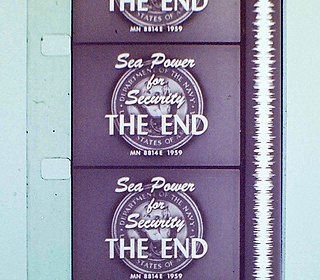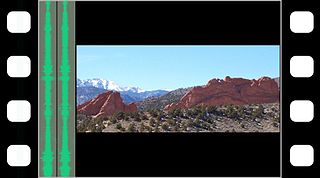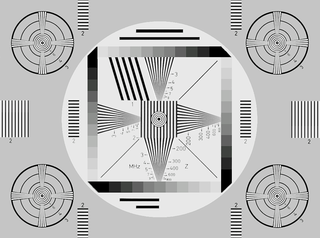
Film stock is an analog medium that is used for recording motion pictures or animation. It is recorded on by a movie camera, developed, edited, and projected onto a screen using a movie projector. It is a strip or sheet of transparent plastic film base coated on one side with a gelatin emulsion containing microscopically small light-sensitive silver halide crystals. The sizes and other characteristics of the crystals determine the sensitivity, contrast and resolution of the film. The emulsion will gradually darken if left exposed to light, but the process is too slow and incomplete to be of any practical use. Instead, a very short exposure to the image formed by a camera lens is used to produce only a very slight chemical change, proportional to the amount of light absorbed by each crystal. This creates an invisible latent image in the emulsion, which can be chemically developed into a visible photograph. In addition to visible light, all films are sensitive to X-rays and high-energy particles. Most are at least slightly sensitive to invisible ultraviolet (UV) light. Some special-purpose films are sensitive into the infrared (IR) region of the spectrum.

Keykode is an Eastman Kodak Company advancement on edge numbers, which are letters, numbers and symbols placed at regular intervals along the edge of 35 mm and 16 mm film to allow for frame-by-frame specific identification. It was introduced in 1990.

35 mm film is a film gauge used in filmmaking, and the film standard. In motion pictures that record on film, 35 mm is the most commonly used gauge. The name of the gauge is not a direct measurement, and refers to the nominal width of the 35 mm format photographic film, which consists of strips 1.377 ± 0.001 inches (34.976 ± 0.025 mm) wide. The standard image exposure length on 35 mm for movies is four perforations per frame along both edges, which results in 16 frames per foot of film.

16 mm film is a historically popular and economical gauge of film. 16 mm refers to the width of the film ; other common film gauges include 8 mm and 35 mm. It is generally used for non-theatrical film-making, or for low-budget motion pictures. It also existed as a popular amateur or home movie-making format for several decades, alongside 8 mm film and later Super 8 film. Eastman Kodak released the first 16 mm "outfit" in 1923, consisting of a camera, projector, tripod, screen and splicer, for US$335. RCA-Victor introduced a 16 mm sound movie projector in 1932, and developed an optical sound-on-film 16 mm camera, released in 1935.

8 mm film is a motion picture film format in which the film strip is eight millimetres (0.31 in) wide. It exists in two main versions – the original standard 8 mm film, also known as regular 8 mm, and Super 8. Although both standard 8 mm and Super 8 are 8 mm wide, Super 8 has a larger image area because of its smaller and more widely spaced perforations.

135 film, more popularly referred to as 35 mm film or 35 mm, is a format of photographic film used for still photography. It is a film with a film gauge of 35 mm (1.4 in) loaded into a standardized type of magazine – also referred to as a cassette or cartridge – for use in 135 film cameras. The engineering standard for this film is controlled by ISO 1007 titled '135-size film and magazine'.

CinemaScope is an anamorphic lens series used, from 1953 to 1967, and less often later, for shooting widescreen films that, crucially, could be screened in theatres using existing equipment, albeit with a lens adapter.

A movie projector is an opto-mechanical device for displaying motion picture film by projecting it onto a screen. Most of the optical and mechanical elements, except for the illumination and sound devices, are present in movie cameras. Modern movie projectors are specially built video projectors.
Negative pulldown is the manner in which an image is exposed on a film stock, described by the number of film perforations spanned by an individual frame. It can also describe whether the image captured on the negative is oriented horizontally or vertically. Changing the number of exposed perforations allows a cinematographer to change both the aspect ratio of the image and the size of the area on the film stock that the image occupies.

Todd-AO is an American post-production company founded in 1953 by Mike Todd and Robert Naify, providing sound-related services to the motion picture and television industries. For more than five decades, it was the worldwide leader in theater sound. The company retains one facility, in the Los Angeles area.

Techniscope or 2-perf is a 35 mm motion picture camera film format introduced by Technicolor Italia in 1960. The Techniscope format uses a two film-perforation negative pulldown per frame, instead of the standard four-perforation frame usually exposed in 35 mm film photography. Techniscope's 2.33:1 aspect ratio is easily enlarged to the 2.39:1 widescreen ratio, because it uses half the amount of 35 mm film stock and standard spherical lenses. Thus, Techniscope release prints are made by anamorphosing, enlarging each frame vertically by a factor of two.
A registration pin is a device intended to hold a piece of film, paper or other material in place during photographic exposure, copying or drawing.

Technirama is a screen process that has been used by some film production houses as an alternative to CinemaScope. It was first used in 1957 but fell into disuse in the mid-1960s. The process was invented by Technicolor and is an anamorphic process with a screen ratio the same as revised CinemaScope (2.35:1), but it is actually 2.25:1 on the negative.

The Academy ratio of 1.375:1 is an aspect ratio of a frame of 35 mm film when used with 4-perf pulldown. It was standardized by the Academy of Motion Picture Arts and Sciences as the standard film aspect ratio in 1932, although similar-sized ratios were used as early as 1928.

Mitchell Camera Corporation was an American motion picture camera manufacturing company established in Los Angeles in 1919. It was a primary supplier of newsreel and movie cameras for decades, until its closure in 1979.
Eastman Color Negative (ECN) is a photographic processing system created by Kodak in the 1950s for the development of monopack color negative motion picture film stock. It is part of the Eastmancolor family of products sold by Eastman Kodak.

Anamorphic format is the cinematography technique of shooting a widescreen picture on standard 35 mm film or other visual recording media with a non-widescreen native aspect ratio. It also refers to the projection format in which a distorted image is "stretched" by an anamorphic projection lens to recreate the original aspect ratio on the viewing screen. The word anamorphic and its derivatives stem from the Greek anamorphoo, compound of morphé with the prefix aná. In the late 1990s and 2000s, anamorphic lost popularity in comparison to "flat" formats such as Super 35 with the advent of digital intermediates; however, in the years since digital cinema cameras and projectors have become commonplace, anamorphic has experienced a considerable resurgence of popularity, due in large part to the higher base ISO sensitivity of digital sensors, which facilitates shooting at smaller apertures.

Spirit DataCine is a telecine and a motion picture film scanner. This device is able to transfer 16mm and 35mm motion picture film to NTSC or PAL television standards or one of many High-definition television standards. With the data transfer option a Spirit DataCine can output DPX data files. The image pick up device is a solid state charge-coupled device. This eliminated the need for glass vacuum tube CRTs used on older telecines. The units can transfer negative film, primetime, intermediate film and print film, stock. One option is a Super 8 gate for the transfer of Super 8 mm film. With a sound pick up option, optical 16mm and 35mm sound can be reproduced, also 16mm magnetic strip sound. The unit can operate stand alone or be controlled by a scene by scene color corrector. Ken Burns created The Civil War, a short documentary film included in the DVD release, on how he used the Spirit DataCine to transfer and remaster this film. The operator of the unit is called a Colorist or Colorist Assistant. The Spirit DataCine has become the standard for high-end real-time film transfer and scanning. Over 370 units are used in post-production facilities around the world. Most current film productions are transferred on Spirit DataCines for Television, Digital television, Cable television, Satellite television, Direct-to-video, DVD, Blu-ray Disc, pay-per-view, In-flight entertainment, Stock footage, Dailies, Film preservation, digital intermediate and digital cinema. The Spirit DataCine is made by DFT Digital Film Technology GmbH in Darmstadt, Germany.

Test film are rolls or loops or slides of photographic film used for testing the quality of equipment. Equipment to be tested could include: telecine, motion picture film scanner, Movie projectors, Image scanners, film-out gear, Film recorders and Film scanners.
















